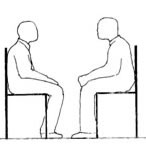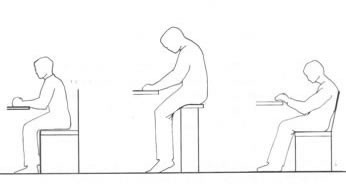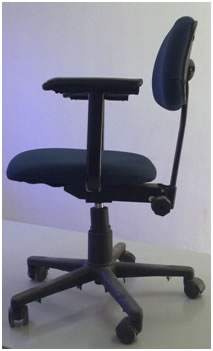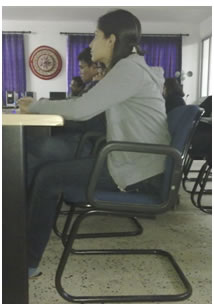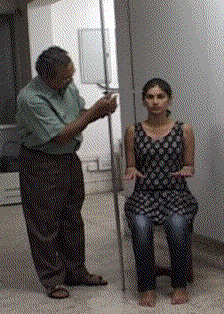Shakshat Virtual Lab 
INDIAN INSTITUTE OF TECHNOLOGY GUWAHATI
|
|
|||
|
Content
|
Sitting Antropometry, static heights |
||
| Theory |
Those physical human body dimensions which have an impact on design dimensions are static when structural. Structural body measurements include direct measurements of various body parts; say heights, lengths, depths, breadths and the circumferences of
|
head, neck, trunk, hands and legs in some standard positions. As standard practice, the collection of body structural data in static body positions is easier than the collection of body functional data in dynamic body positions. When these dimensions are taken in sitting static posture it is called sitting static anthropometry.
|
|
| About experiment | |||
| Measuring procedures | |||
| Step by step procedure | |||
| Direct methods | |||
| Indirect methods |
|
Adaptation of a bent neck posture due to a faulty work surface and body-supportive furniture: Proper anthropometric dimension to be considered. |
|
| Animated demonstration | |||
|
External human body dimensional measurements i.e. heights, lengths, breadths, depths and circumferences, taken |
when a man is placed in a static sitting erect posture, chest forward, chin up, look horizontal with hip, elbow, knee and heel maintainted at 90 degree angle ; are known as static sitting anthropometry. |
||
About experiment |
|||
|
This Study aims at understanding the various body heights in static sitting posture; it also mentions measuring techniques and equipment used and provides same
|
reference data to acquaint with the data set in Indian population context in various ranges of %-ile figures and respective ratio value between parameters and height. For detailed data for other dimensions refer the Home page data sheet. |
||
|
The presentation acquaints
|
|
|
|
Procedure |
|||
|
For sitting measurements, subjects are asked to sit erect on a comfortable height stool where he maintains heel, knee, hip and elbow at 90 degrees with chest forward, chin up, arms extended forward with upper arm hanging down vertical. |
Relevant measurements are taken using anthropometric rod set as shown in the figure and/ or using different types of grids (anthropometric board etc) are also used to measure specific land marks, here in the heights |
||
|
|
|||
|
Both direct and indirect measuring procedures are followed to collect anthropometric data from selected subjects in a particular population. Direct and indirect |
body measuring procedures may be considered separately or taken both simultaneously, depending on the context of the dimensional requirement and the suitability of the study. |
||
|
Measuring dimensions: technique
|
|||
|
The measuring methods as demonstrated in the video and illustrations presented herein may be followed with the relevant experimental set up using (A) anthropometer set (e.g., rods marked in part millimeter scale are joined together to make a single scale from 0 to 200 cm and using various sliding branches),
|
(B) anthropometric board and other relevant devices specifically developed for suitability to measure respective measurements.
Data treatments - relevant calculations are to be followed. Data usage- principles and thumb rules are to be maintained. |
||
|
Direct body measuring instruments mostly used are:
|
Indirect methods
|
||
|
Indirect measurements may be taken through photographic methods, using still photography and filming the whole body and/or parts from different angles against a marked grid background, or superimposition of a grid on the photographed human body. To guard against parallax errors - problems where the actual dimensions may change - much care must be taken.
For dynamic measurements, subjects are asked to perform the intended tasks in actual and/or simulate situations and the relevant measurements are taken. Subjects may leave some marks denoting the limits to which they can stretch their limbs in a comfortable position. Different types of grids are also used to measure these marks. |
||
|
Click the image below and press "^" up arrow and "V" down arrow on the keyboard to move the scale.
|
Demonstration of land marks and measuring procedure using anthropometric rod set.
|
||
